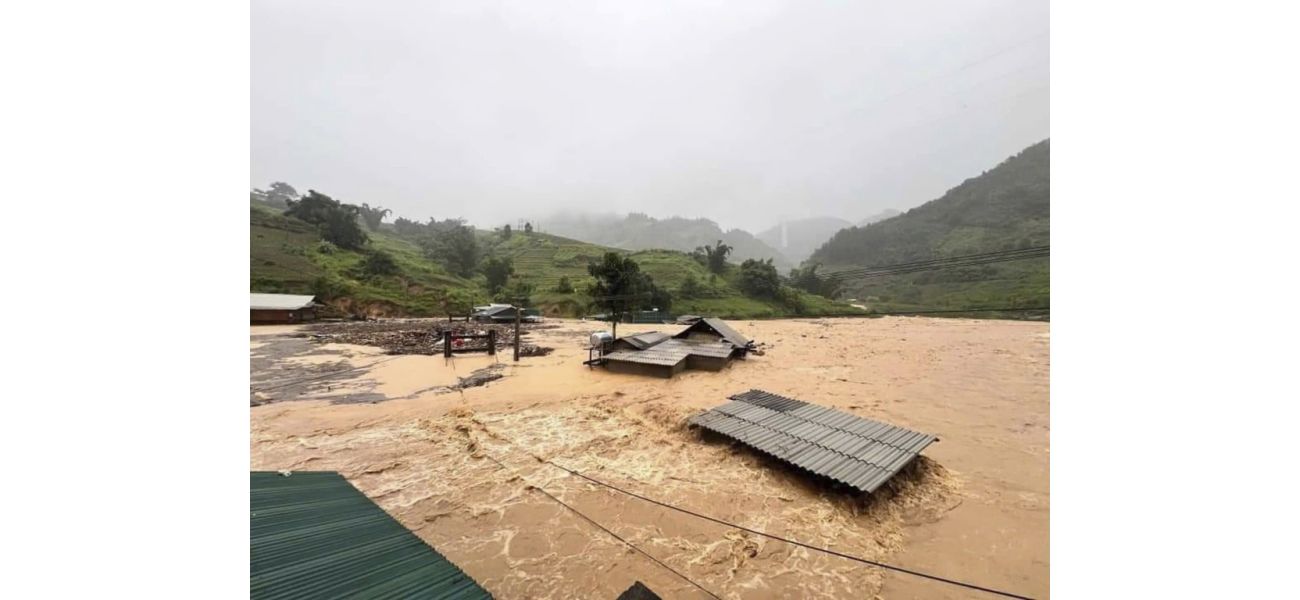14 dead in Vietnam, strongest storm in 10 years.
Typhoon Yagi has caused 14 deaths and 176 injuries in Vietnam's northern region.
September 8th 2024.

According to state media, Typhoon Yagi has caused destruction in Vietnam, resulting in the loss of lives and injuries to many. Even though its strength is decreasing, officials are warning of more heavy rain in the country.
This typhoon is being described as one of the most powerful in the last ten years, leaving over 3 million people without electricity in northern Vietnam. It has also caused significant damage to agricultural land, affecting over 116,000 hectares where rice and fruit are grown. Due to the severity of the storm, hundreds of flights had to be cancelled, and four airports were shut down.
The typhoon first hit the northern coastal provinces of Quang Ninh and Haiphong with wind speeds of up to 149km/h on Saturday afternoon. It continued to rage for 15 hours before weakening into a tropical depression early Sunday morning. Vietnam's meteorological department has warned of potential floods and landslides in low-lying areas, as well as heavy rain in northern and central provinces.
In the capital city of Hanoi, municipal workers, along with army and police forces, have been working tirelessly to clear the aftermath of the storm. Fallen trees, billboards, and damaged buildings are being assessed while electricity poles and rooftops are being replaced. Sadly, a woman lost her life after a tree fell on her in the capital before the typhoon even made landfall.
One of the affected provinces, Quang Ninh, is famous for its UNESCO World Heritage site, Ha Long Bay. The typhoon caused many cruises in the area to be cancelled before it hit. Haiphong, another affected province, is a hub for industries such as automobile manufacturing and is home to factories like VinFast and Apple supplier Pegatron.
The storm also caused power outages in Quang Ninh and Thai Binh provinces. In preparation for the typhoon, the government had issued alerts and evacuated those living in vulnerable areas. Several airports were closed, including the one in Hanoi.
Efforts were made to make trees in Hanoi less prone to falling by pruning them, but the strong winds and rain were still able to knock over some of them, along with billboards in other northern cities. Local media reported that many boats were swept away by the storm.
Bao Ngoc Cao, a 24-year-old businesswoman from Hanoi, shared that she and her family are staying indoors to stay safe. She also mentioned that the last time a typhoon of this magnitude hit Vietnam was in 2013 and that the storms usually weaken before reaching the capital. However, she emphasized the importance of being prepared for any potential dangers.
Before reaching Vietnam, Typhoon Yagi also caused damage in China's Hainan province, leaving three people dead and nearly 100 injured. It affected over 1.2 million people and forced 420,000 to evacuate before making landfall. In Guangdong province, half a million people were also evacuated before the typhoon's second landfall.
In Hong Kong, over 270 people had to take refuge in government shelters, and more than 100 flights were cancelled due to the storm. The typhoon caused heavy rain and strong winds, resulting in the felling of several trees. Trading on the stock market, bank services, and schools were also affected.
Before reaching Vietnam, Typhoon Yagi had already caused destruction in the Philippines, resulting in the loss of lives and displacement of thousands of people. It affected more than 2.3 million people in northern and central provinces and disrupted classes, work, and transportation services for days.
Director of the Earth Observatory of Singapore, Benjamin Horton, shared that storms like Typhoon Yagi are becoming stronger due to climate change. Warmer ocean waters provide more energy for the storms, leading to higher wind speeds and heavier rainfall. He also mentioned that climate change is causing storms to move to different locations, exposing new areas to their impact.
To better prepare for strong typhoons, Horton suggests protecting natural systems like reefs and rivers, building more resilient structures, and improving existing infrastructure. These measures can help countries better cope with the effects of climate change and severe storms like Typhoon Yagi.
This typhoon is being described as one of the most powerful in the last ten years, leaving over 3 million people without electricity in northern Vietnam. It has also caused significant damage to agricultural land, affecting over 116,000 hectares where rice and fruit are grown. Due to the severity of the storm, hundreds of flights had to be cancelled, and four airports were shut down.
The typhoon first hit the northern coastal provinces of Quang Ninh and Haiphong with wind speeds of up to 149km/h on Saturday afternoon. It continued to rage for 15 hours before weakening into a tropical depression early Sunday morning. Vietnam's meteorological department has warned of potential floods and landslides in low-lying areas, as well as heavy rain in northern and central provinces.
In the capital city of Hanoi, municipal workers, along with army and police forces, have been working tirelessly to clear the aftermath of the storm. Fallen trees, billboards, and damaged buildings are being assessed while electricity poles and rooftops are being replaced. Sadly, a woman lost her life after a tree fell on her in the capital before the typhoon even made landfall.
One of the affected provinces, Quang Ninh, is famous for its UNESCO World Heritage site, Ha Long Bay. The typhoon caused many cruises in the area to be cancelled before it hit. Haiphong, another affected province, is a hub for industries such as automobile manufacturing and is home to factories like VinFast and Apple supplier Pegatron.
The storm also caused power outages in Quang Ninh and Thai Binh provinces. In preparation for the typhoon, the government had issued alerts and evacuated those living in vulnerable areas. Several airports were closed, including the one in Hanoi.
Efforts were made to make trees in Hanoi less prone to falling by pruning them, but the strong winds and rain were still able to knock over some of them, along with billboards in other northern cities. Local media reported that many boats were swept away by the storm.
Bao Ngoc Cao, a 24-year-old businesswoman from Hanoi, shared that she and her family are staying indoors to stay safe. She also mentioned that the last time a typhoon of this magnitude hit Vietnam was in 2013 and that the storms usually weaken before reaching the capital. However, she emphasized the importance of being prepared for any potential dangers.
Before reaching Vietnam, Typhoon Yagi also caused damage in China's Hainan province, leaving three people dead and nearly 100 injured. It affected over 1.2 million people and forced 420,000 to evacuate before making landfall. In Guangdong province, half a million people were also evacuated before the typhoon's second landfall.
In Hong Kong, over 270 people had to take refuge in government shelters, and more than 100 flights were cancelled due to the storm. The typhoon caused heavy rain and strong winds, resulting in the felling of several trees. Trading on the stock market, bank services, and schools were also affected.
Before reaching Vietnam, Typhoon Yagi had already caused destruction in the Philippines, resulting in the loss of lives and displacement of thousands of people. It affected more than 2.3 million people in northern and central provinces and disrupted classes, work, and transportation services for days.
Director of the Earth Observatory of Singapore, Benjamin Horton, shared that storms like Typhoon Yagi are becoming stronger due to climate change. Warmer ocean waters provide more energy for the storms, leading to higher wind speeds and heavier rainfall. He also mentioned that climate change is causing storms to move to different locations, exposing new areas to their impact.
To better prepare for strong typhoons, Horton suggests protecting natural systems like reefs and rivers, building more resilient structures, and improving existing infrastructure. These measures can help countries better cope with the effects of climate change and severe storms like Typhoon Yagi.
[This article has been trending online recently and has been generated with AI. Your feed is customized.]
[Generative AI is experimental.]
0
0
Submit Comment





